Notebook - June 7, 2000
Graduate student discovers most
distant object in the universe
This latest object, a quasar, is 12 billion years old
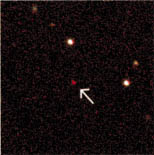 It seems that Lucretius was right. Back in 50 B.C.E., way before fancy
telescopes and computers that read astronomical data, the Roman philosopher
posited the infiniteness of the universe by saying that when you reach the
end of it, just throw a spear-you will see that it flies on into what Lucretius
called the wide inane.
It seems that Lucretius was right. Back in 50 B.C.E., way before fancy
telescopes and computers that read astronomical data, the Roman philosopher
posited the infiniteness of the universe by saying that when you reach the
end of it, just throw a spear-you will see that it flies on into what Lucretius
called the wide inane.
In these modern times scientists routinely seem to discover yet another
"most distant object in the universe." The latest isn't a spear,
though, but a quasar.
In April graduate student Xiaohui Fan, along with a team of scientists
from other institutions, identified a red-shift quasar estimated to be 12
billion years old, meaning it took 12 billion years for the quasar's light
to reach Earth. Current thinking puts the age of the universe at 13 billion
years.
Distant quasars, stars, and galaxies are significant because of their
age. Seeing objects in their so-called infancy gives scientists more data
to develop theories and better understand the origins of the universe. This
particular quasar, for instance, is being seen as it existed when the universe
was less than a billion years old.
Earlier this year Fan, who works with Michael Strauss, associate professor
of astrophysical sciences, received the Porter Ogden Jacobus fellowship
that honors outstanding graduate students.
The data Fan used were collected from the Sloan Digital Sky Survey (www.sdss.org),
a huge project sponsored by nine institutions, including Princeton, that
is surveying one-quarter of the sky and 100 million celestial objects. The
camera for this project was developed by James Gunn, professor of astronomy,
and is able to collect data on objects that are thousands of times dimmer
than could be detected by previous surveys.
Quasars, or quasi-stellar objects, are believed to be powerful emissions
of light that result from matter pouring into an especially massive black
hole at the center of a galaxy. Before Fan identified this particular quasar,
the most distant object was a galaxy discovered last year that was 11.5
billion years old.
-L.O.
Back to full menu of Notebook
Implementing the Wythes Report
In response to the trustees' approval of the Wythes Report recommendations,
the university administration is now engaged in implementing the will of
the trustees and at the same time addressing student concerns revolving
around a larger student body.
The foremost concern is where to put all these new students. The Philadelphia
architectural firm Kieran Timberlake was hired in January to assess possible
locations and by the middle of May seemed to have settled on three sites
as the most promising of the seven or so they looked at. The sites under
consideration are: south of Dillon Gymnasium, in the area of the tennis
courts, which would need to be relocated; the area north of McCarter Theatre,
where there is some faculty housing that would need to be relocated; and
the area north of Forbes College, which abuts the golf course. This final
location would require moving the Springdale club house and several residences
as well.
As is to be expected, there are advantages and disadvantages to each
site. According to Richard R. Spies, vice president for finance and administration,
the trustees will most likely not approve a site until much later this year,
probably in the fall. The factors that will play into the decision include,
according to Spies, location, preservation and/or enhancement of open space,
consistency with long-term planning issues, cost, timing, number and complexities
of enabling projects, and complexity of the approvals process.
According to Robert K. Durkee '69, vice president for public affairs,
the trustees "will want to make the decision with two considerations
in mind. . . . One is that any space they use for this purpose therefore
becomes unavailable in the future for other potential uses." In other
words, does a residential college provide the optimal use for a particular
site? "The second consideration asks what impact construction of a
college would have on the surrounding lands and on potential for further
development of that part of campus in the future." Durkee points out
that the trustees have to make their decision knowing they might be called
upon in the future to make other decisions and not knowing what those decisions
might be.
At a presentation made to the larger university community in May, Steve
Kieran, principal of the architectural firm, said that the future residential
college would contain every amenity that is currently in any of the existing
colleges, such as workout rooms, performance space, cooking areas, computer
clusters, etc. Kieran recommends that the new college resemble Forbes, which
he said seemed to be the most conducive for community building. In talking
with students, he said, his firm found that the separate entryways that
exist in many of the older dorms do not lend themselves to bringing together
more than the handful of students who live on each entryway. At this point
no architectural firm has been selected to design the new college.
As tricky as it is to site a new residential college, it looks as if
it will be trickier still to plan faculty hires and graduate student acceptances.
One of the primary concerns of the undergraduates is the quality of undergraduate
teaching, and the fear is that with more students possibly gravitating to
already popular departments, preceptorials will get larger and advisers
scarcer. But simply hiring more professors in popular departments isn't
necessarily the solution. It is unpredictable what can happen from year
to year with particular departments. For instance, two years ago 142 sophomores
planned to major in economics; last year 118 did so, and this year only
70 indicated plans to major in economics. However, in the revised Wythes
Report, the trustees state that the university can admit more graduate students
to certain departments with high numbers of concentrators.
Joseph H. Taylor, dean of the faculty, said his "main job is managing
the evolution of the faculty. There will be growth where there is growth."
Yes, the university will hire new faculty, but not, according to Taylor,
at a great rate. "Faculty growth plans are in place for the newer initiatives,
such as the genomics institute, and in computer sciences, and electrical
engineering and other areas where there are new intellectual activities."
Another major student concern has to do with the quality of life outside
the classroom. Thomas H. Wright, Jr., vice president of the university,
points out that the final Wythes Report underscores the university's commitment
to provide an outstanding educational experience both in and out of the
classroom. The report states that money will undoubtedly be directed toward
areas of student life that most affect undergraduate life: the Frist Campus
Center, residential colleges, programs offered and supported by the offices
of undergraduate students, athletics, health services, and religious life.
-L.O.
Back to full menu of Notebook
Eight named to tenured faculty
Four associate professors move up to professor
At its April 15 meeting, the Board of Trustees approved the appointment
of one full professor, Athanassios Panagiotopoulos (chemical engineering),
and the promotion of one assistant professor, Elizabeth Gould (psychology),
to professor. It also promoted six to associate professor: Bonnie Bassler
(molecular biology), Luigi Martinelli *87 (mechanical and aerospace engineering),
Kenneth Mills (history), Catherine Peters (civil and environmental engineering),
Eileen Reeves (comparative literature), and Rob Wegman (music). All appointments
are effective July 1.
Panagiotopoulos, who specializes in computational engineering, comes
from Cornell University. He earned a Ph.D. at the Massachusetts Institute
of Technology in 1986.
Gould studies the way nerve cells survive and proliferate in the brain.
Gould received her Ph.D. from the University of California, Los Angeles,
in 1988 and spent three years as a postdoctoral fellow and five as assistant
professor of neuroendocrinology at Rockefeller University. She joined Princeton
as assistant professor in 1997.
Bassler studies the molecular mechanisms that bacteria use for intercellular
communication. She earned her Ph.D. in 1990 at Johns Hopkins University.
She was a postdoctoral fellow and then a research scientist at the Agouron
Institute in La Jolla, California, from 1990 to 1994, when she came to Princeton
as assistant professor.
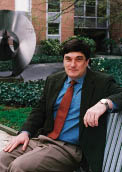 Martinelli's field is computational fluid dynamics, focusing on the
development of numerical methods and computer codes for the simulation of
viscous flow past complex configurations. He received his Ph.D. from Princeton
in 1987. From 1987 to 1994 he was a member of the research staff and then
joined the faculty as an assistant professor.
Martinelli's field is computational fluid dynamics, focusing on the
development of numerical methods and computer codes for the simulation of
viscous flow past complex configurations. He received his Ph.D. from Princeton
in 1987. From 1987 to 1994 he was a member of the research staff and then
joined the faculty as an assistant professor.
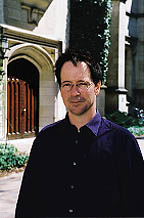 Mills studies colonial Latin America and the early modern Spanish world,
with a special interest in evangelization and religious and cultural change.
He received his D.Phil. from Oxford University, where he was a Rhodes Scholar
from 1988 to 1991. He came to Princeton in 1993 as assistant professor.
Mills studies colonial Latin America and the early modern Spanish world,
with a special interest in evangelization and religious and cultural change.
He received his D.Phil. from Oxford University, where he was a Rhodes Scholar
from 1988 to 1991. He came to Princeton in 1993 as assistant professor.
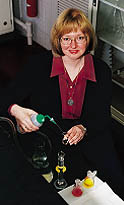 Peters is a member of the Program in Environmental Engineering and Water
Resources. Her research interests include processes governing the behavior
of multicomponent organic contaminants in the environment, mathematical
modeling of the chemistry of pollutants, and remediation techniques for
hazardous waste sites. Peters earned her Ph.D. in 1992 in civil engineering
and engineering and public policy at Carnegie Mellon University. After two
years as a postdoctoral fellow at Michigan, she came to Princeton as assistant
professor.
Peters is a member of the Program in Environmental Engineering and Water
Resources. Her research interests include processes governing the behavior
of multicomponent organic contaminants in the environment, mathematical
modeling of the chemistry of pollutants, and remediation techniques for
hazardous waste sites. Peters earned her Ph.D. in 1992 in civil engineering
and engineering and public policy at Carnegie Mellon University. After two
years as a postdoctoral fellow at Michigan, she came to Princeton as assistant
professor.
Reeves's special areas of interest are early modern scientific literature
and journalism. She earned a Ph.D. in 1987 at Stanford University. She joined
the faculty at Princeton in 1993 as assistant professor of comparative literature
after four years at the University of Pennsylvania in the Romance languages
and literature department.
Wegman's research focuses on medieval and Renaissance music. Wegman earned
a Ph.D. in 1993 at the University of Amsterdam. He came to Princeton as
assistant professor in 1995 after four years at Oxford University, first
as a junior research fellow and then as a postdoctoral fellow.
Four associate professors move up
Four associate professors have been promoted to the rank of professor:
Scott Burnham (music), Andrew Ford (classics), Richard Register (chemical
engineering), and Bruce Western (sociology).
Burnham, who has been at Princeton since 1989, teaches courses on music
theory and analysis, history of tonal theory, and the music of Beethoven,
Schubert, Mozart and others.
Ford is a specialist in Ancient Greek literature and the history of literary
criticism and has been a member of the faculty since 1986. He teaches Greek
language and literature and courses for the Humanities Council.
Register, whose field is polymer science and engineering, currently teaches
courses in polymer synthesis and polymer structure and properties. On the
faculty since 1990, he is a member of the Princeton Materials Institute
and the Center for Photonics and Optoelectronic Materials.
Western, who joined the Princeton faculty in 1993, works in the areas
of political sociology, economic sociology and methodology.
Back to full menu of Notebook
In memoriam
Gerald Garvey *62
Gerald Garvey *62, professor of politics, died April 9 at the Medical
Center of Princeton from complications of cancer. He was 64.
After earning his Ph.D. in political science from Princeton in 1962,
Garvey was an instructor at the Air Force Academy. He then served the government
in a variety of offices, including that of the vice chief of staff of the
Air Force and the Federal Power Commission. He joined the faculty in 1968
as an associate professor and became a professor in 1972.
He taught American Democracy, American Bureaucracy and Public Administration,
The Politics of Corporate Governance, and other courses in American constitutional
interpretation and political thought.
Garvey was comaster, along with his wife, Lou Ann Benshoof, of Princeton
Inn College (now Forbes College) from 1977-80, and he was master of Stevenson
Hall from 1970-74. In 1999 he received the Stanley Kelley Teaching Award,
given by the politics department for distinguished teaching.
Back to full menu of Notebook
Packing round objects
Professor debunks theory of how spheres fit in containers
When professor of chemistry Sal Torquato says, "Stirred, not shaken,"
he's not referring to a martini, but to how spheres stack when poured into
a container.
If ice cubes were round, and they were poured into a glass and then stirred
and/or shaken, previous stacking theories say that 64 percent of the volume
would be taken up by ice, leaving 36 percent for libation. Now, Torquato
has demonstrated with computer simulation and theoretical observation that
the resultant stacking-referred to as random close packing-long considered
universal, is simply wrong. "People have been trying for years to theoretically
predict what the percentage would be-to no avail," Torquato says, "and
it's because the concept was totally ill-defined."
Instead, spheres may fit into a container if poured one way, and may
not fit if poured another way. "When people called it 'random close
packing,' they had no idea what they meant by randomness," Torquato
says. To resolve the problem, Torquato, along with professor of chemical
engineering Pablo Debenedetti and graduate student Tom Truskett, proposed
a formal method for measuring randomness, a mathematical expression for
how strongly the structure varies from the most ordered face-centered cubic
array, a ubiquitous concept in freshman chemistry and materials science.
Torquato, a faculty member of the Princeton Materials Institute, said
this new approach could have important implications for the design of materials.
For more information, see http://cherrypit.princeton.edu:80/.
-L.O.
Back to full menu of Notebook
Que Serra sera
A sculpture for us to see
 On a brutally hot day in May that did not at all resemble a normal day
in spring, university work crews began to erect a massive sculpture that
does not at all resemble any other sculpture on campus.
On a brutally hot day in May that did not at all resemble a normal day
in spring, university work crews began to erect a massive sculpture that
does not at all resemble any other sculpture on campus.
Still untitled, the Core-10 steel structure, comprising three parallel,
S-shaped, 15-foot-high curves, each 94 feet long, was created by the sometimes
controversial New York City artist Richard Serra. Located on a pathway between
Peyton and Fine Halls, the sculpture can be walked through, as the artist
intended.
Peter Joseph '72, who died of cancer in 1998, commissioned the million-dollar
artwork in honor of his parents and donated it to the university. Serra,
who had the work built in Germany, has taught as a visiting professor in
the visual arts department.
In Brief
A group of people calling themselves the United Parents Protesting
Singer came to the FitzRandolph Gate on April 22 to stage a protest
and ask the university to dismiss Peter Singer, Ira W. DeCamp professor
of bioethics, for his controversial views on people with disabilities. The
group presented a petition with 1,500 signatures to university vice president
Thomas Wright to give to the Board of Trustees. This is the second anti-Singer
protest on campus. The first occurred on Singer's first day of classes and
was staged by Not Dead Yet, a Chicago-based organization of people with
disabilities.
On April 12, President Clinton presented Gennady Shvets, a physicist
at the Princeton Plasma Physics Laboratory, with a Presidential Early Career
Award for Scientists and Engineers. Shvets was cited for "theoretical
and computational investigations of the interaction of ultra-strong pulses
with plasmas, with applications to inertial confinement fusion, to plasma-based
particle accelerators, to new radiation sources based on beams and plasmas."
Shvets, who comes from Kiev, Ukraine, emigrated to Baltimore in 1989, received
his doctorate from the Massachusetts Institute of Technology in 1995, and
came to PPPL that year.
An ongoing concern in the state of New Jersey is the need for automatic
sprinklers in university and college dormitories. Prompting immediate
legislation this year was a fire in January in a Seton Hall University dormitory
that killed three students. State legislators continue to work out the specifics,
including the time frame, of a bill that will require sprinklers in all
sleeping and common areas of dormitories. At Princeton, according to Jon
Hlafter, director of physical planning, 1,000 of the 5,000 bedspaces, including
those at the Graduate College, are sprinklered. As the university renovates
dorms, sprinklers are being installed, and he expects all rooms will be
sprinklered within five years.
On April 21, a small chemical spill in a laboratory at the Engineering
Quad sent three graduate students and a secretary to the hospital, where
they were treated and released; there were no injuries. The spill occurred
when one of the researchers tripped and knocked over a glass beaker containing
chlorobenzene, a stinky, volatile, flammable liquid used to coat computer
chips.
At the end of April hundreds of participants celebrated the 10th anniversary
of the Center for Human Values at five panel discussions. Questions
debated over the two-day celebration were: How Can Values Be Taught in the
University; What Do Citizens Owe Their Constitutional Democracy, How Should
We Address the Greatest Evils and Injustices of Our Time?, What's Public,
What's Private, and Should Popular Culture Support Morality? The first question
was addressed by panelists President Shapiro, Professor Toni Morrison, president
of Smith College Ruth Simmons, Professor Peter Singer, columnist George
F. Will *68, and Susan Wolf, a professor of philosophy at Johns Hopkins
University. A warm, if not heated, exchange between Will and Morrison after
the panelists had spoken was enjoyed by the audience and soon quelled by
a diplomatic Shapiro. The center, which has 24 faculty members associated
with it, began in 1990 with a $21 million gift from Laurance Rockefeller
'32.
The university has named John B. Webb the director of the Program
in Teacher Preparation, effective July 1. He succeeds Marue E. Walizer,
who retires at the end of this month. Webb earned his doctorate in education
at New York University in 1986, and since then has been chair of the foreign
language department at Hunter College High School in New York. He holds
two adjunct teaching positions, one at Hunter College of the City University
of New York and one at Manhattanville College.
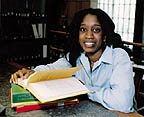 Janelle Wright '00 was awarded $15,000 as the recipient of the
university's Labouisse Fellowship, which is given to a graduating senior
or first-year alumnus who is planning a career in the area of development
and modernization. Wright will work in Durban, South Africa, helping with
the establishment of a community-based corporation. She will be working
with the Built Environment Support Group, a nonprofit organization that
focuses on improving the living conditions of residents in urban areas of
Kwa-Zulu-Natal. The Labouisse Fellowship was established in 1987 to honor
the memory of Henry Richardson Labouisse '26, who held posts in the State
Department and United Nations for nearly 40 years. He served as head of
UNICEF from 1965 to 1979.
Janelle Wright '00 was awarded $15,000 as the recipient of the
university's Labouisse Fellowship, which is given to a graduating senior
or first-year alumnus who is planning a career in the area of development
and modernization. Wright will work in Durban, South Africa, helping with
the establishment of a community-based corporation. She will be working
with the Built Environment Support Group, a nonprofit organization that
focuses on improving the living conditions of residents in urban areas of
Kwa-Zulu-Natal. The Labouisse Fellowship was established in 1987 to honor
the memory of Henry Richardson Labouisse '26, who held posts in the State
Department and United Nations for nearly 40 years. He served as head of
UNICEF from 1965 to 1979.
Daniel Wesley '00 won a Churchill Scholarship, provided by the
Winston Churchill Foundation of the United States, which will allow him
to study at Churchill College at Cambridge University. The award is given
annually to outstanding American students for graduate study in engineering,
mathematics, or the physical and natural sciences. Wesley's field is physics.
At Princeton he won two prizes in physics: the Pyka Prize, for exceptional
progress as a freshman, and the Kusaka Prize, awarded to outstanding physics
undergraduates. After studying at Cambridge, where he plans to earn a certificate
of advanced study in mathematics, he intends to return to the U.S. to pursue
a doctorate in physics.
Back to full menu of Notebook
tech notes
Encrypting for security; interactive Web study guides
Princeton, along with a half-dozen other research universities, is among
the first to adopt a new form of encryption technology that uses "digital
certificates" to verify the online identity of students and faculty
and allow them access to a range of online information.
Digital certificates, the latest development in Internet security, are
tiny files stored in an individual user's Web browser that use coded information
to identify a particular individual or institution. Each file contains an
extremely long sequence of characters that is virtually impossible to crack
or forge.
The digital certificate verifies for other computers that "people
are in fact who their computers say they are," according to Ira Fuchs,
outgoing vice president for computing and information technology.
Fuchs admits that "digital-certificate encryption is so complicated
that many universities don't want it. Princeton is moving forward with two
pilot projects in areas that can benefit from digital certificates."
One will be to protect sensitive health-related information that students
submit to health providers at McCosh. The other project will enable authorized
users to do research at home or anywhere else, using any server to gain
access to databases and electronic copies of journals outside their campus
collection.
In November, Princeton was issued the first institutional digital certificate
by the Corporation for Research and Educational Networking, a nonprofit
organization of colleges and universities which is facilitating the shift
to digital certificate encryption technology. www.cren.net
final exam.com
"Is this going to be on the exam?" is the single most commonly
asked question in college, and Jack Goodman '89 and his brother Will '83
have created a new e-business, Final-exam.com, that will help students whether
or not they get an answer to that question. The company plans to sell interactive
Web-based study guides for survey-level college courses.
Among the professors the company has engaged as project editors are Princeton's
James L. Gould, professor of ecology and evolutionary biology, and Aaron
Lemonick, professor, emeritus, of physics. Former university president Robert
F. Goheen '40 *48 is on its board of academic advisers.
According to Jack Goodman, the company "is responding to college
students' high degree of connectivity. Students want to learn this way."
Directed to the Web site by their professors, students will be able to
buy an online study guide for some introductory courses. The guides will
feature interactive components and offer diagnostic testing that allows
students to track their progress and compare their competency to that of
other students. Professors can also customize the study guides based on
material they want to emphasize, something they cannot do with the currently
available printed study guides. They can also choose to restrict any customization
to their students or to make it available to all students who purchase the
guides.
Professor Gould has been using his own computer-based study guides through
the Princeton network for years. "Students don't stop coming to lectures,"
he explained. "And they do feel they've been given every opportunity
to do well." www.Final-exam.com
-Diane Krumrey
Back to full menu of Notebook
Talks on Campus
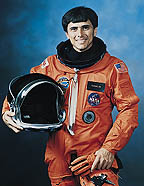 Franklin Chang-Diaz, the U.S. astronaut
with the most shuttle missions, spoke on May 8 as part of a lecture series
sponsored by the Plasma Physics Laboratory and the School of Engineering
and Applied Science. His talk, Plasma Rockets for the Next Generation, included
his vision of the future of space flight.
Franklin Chang-Diaz, the U.S. astronaut
with the most shuttle missions, spoke on May 8 as part of a lecture series
sponsored by the Plasma Physics Laboratory and the School of Engineering
and Applied Science. His talk, Plasma Rockets for the Next Generation, included
his vision of the future of space flight.
David R. Murray, former professor of anthropology at Brandeis
University and now director of research for Statistical Assessment Service
in Washington, D.C., spoke on April 25 to a group of chemists about how
much of the press jumped to poor conclusions about the studies that suggested
Thomas Jefferson fathered a child by his slave Sally Hemings. Murray said
that much of the media does not interpret science information accurately.
The studies regarding Jefferson and Hemings suggest only that a Jefferson
fathered Hemings's child, but it could have been one of another 24 living
in the area, and not necessarily the third president, Murray said.
The Reverend Eugene F. Rivers III, a former gang member and now
a pastor and community activist in Boston, spoke on April 25 at the Woodrow
Wilson School about the need for upper-class black and white communities
to help the urban poor. Inner cities need church leaders who can give moral
consistency to their constituents by way of fatherhood seminars, cultural
literacy programs, and job and education opportunities, said Rivers.
Victor Fuchs, professor, emeritus, of economics at Stanford University,
came on April 26 to lecture and meet with students. The May 2 New York Times
reported some of his views on health care: "I think we should have
universal coverage financed by a general, broad-based tax which is earmarked
for health care-such as value-added tax-which would give every American
a voucher to be part of some health care plan. . . . I like to think of
it as a multitiered system where every American has basic coverage and people
have options to buy more, not subsidized by taxes but with their own after-tax
dollars."
New Jersey Governor Christine Todd Whitman's talk at the Woodrow
Wilson School on April 27, entitled Sewers: The Last Frontier of Smart Growth,
concerned the state's open space and how sewers are the determining factor
when it comes to land development.
Back to full menu of Notebook
GO TO
the Table of Contents of the current issue
GO TO
PAW's home page
paw@princeton.edu
 It seems that Lucretius was right. Back in 50 B.C.E., way before fancy
telescopes and computers that read astronomical data, the Roman philosopher
posited the infiniteness of the universe by saying that when you reach the
end of it, just throw a spear-you will see that it flies on into what Lucretius
called the wide inane.
It seems that Lucretius was right. Back in 50 B.C.E., way before fancy
telescopes and computers that read astronomical data, the Roman philosopher
posited the infiniteness of the universe by saying that when you reach the
end of it, just throw a spear-you will see that it flies on into what Lucretius
called the wide inane. Martinelli's field is computational fluid dynamics, focusing on the
development of numerical methods and computer codes for the simulation of
viscous flow past complex configurations. He received his Ph.D. from Princeton
in 1987. From 1987 to 1994 he was a member of the research staff and then
joined the faculty as an assistant professor.
Martinelli's field is computational fluid dynamics, focusing on the
development of numerical methods and computer codes for the simulation of
viscous flow past complex configurations. He received his Ph.D. from Princeton
in 1987. From 1987 to 1994 he was a member of the research staff and then
joined the faculty as an assistant professor. Mills studies colonial Latin America and the early modern Spanish world,
with a special interest in evangelization and religious and cultural change.
He received his D.Phil. from Oxford University, where he was a Rhodes Scholar
from 1988 to 1991. He came to Princeton in 1993 as assistant professor.
Mills studies colonial Latin America and the early modern Spanish world,
with a special interest in evangelization and religious and cultural change.
He received his D.Phil. from Oxford University, where he was a Rhodes Scholar
from 1988 to 1991. He came to Princeton in 1993 as assistant professor. Peters is a member of the Program in Environmental Engineering and Water
Resources. Her research interests include processes governing the behavior
of multicomponent organic contaminants in the environment, mathematical
modeling of the chemistry of pollutants, and remediation techniques for
hazardous waste sites. Peters earned her Ph.D. in 1992 in civil engineering
and engineering and public policy at Carnegie Mellon University. After two
years as a postdoctoral fellow at Michigan, she came to Princeton as assistant
professor.
Peters is a member of the Program in Environmental Engineering and Water
Resources. Her research interests include processes governing the behavior
of multicomponent organic contaminants in the environment, mathematical
modeling of the chemistry of pollutants, and remediation techniques for
hazardous waste sites. Peters earned her Ph.D. in 1992 in civil engineering
and engineering and public policy at Carnegie Mellon University. After two
years as a postdoctoral fellow at Michigan, she came to Princeton as assistant
professor. On a brutally hot day in May that did not at all resemble a normal day
in spring, university work crews began to erect a massive sculpture that
does not at all resemble any other sculpture on campus.
On a brutally hot day in May that did not at all resemble a normal day
in spring, university work crews began to erect a massive sculpture that
does not at all resemble any other sculpture on campus.  Janelle Wright '00 was awarded $15,000 as the recipient of the
university's Labouisse Fellowship, which is given to a graduating senior
or first-year alumnus who is planning a career in the area of development
and modernization. Wright will work in Durban, South Africa, helping with
the establishment of a community-based corporation. She will be working
with the Built Environment Support Group, a nonprofit organization that
focuses on improving the living conditions of residents in urban areas of
Kwa-Zulu-Natal. The Labouisse Fellowship was established in 1987 to honor
the memory of Henry Richardson Labouisse '26, who held posts in the State
Department and United Nations for nearly 40 years. He served as head of
UNICEF from 1965 to 1979.
Janelle Wright '00 was awarded $15,000 as the recipient of the
university's Labouisse Fellowship, which is given to a graduating senior
or first-year alumnus who is planning a career in the area of development
and modernization. Wright will work in Durban, South Africa, helping with
the establishment of a community-based corporation. She will be working
with the Built Environment Support Group, a nonprofit organization that
focuses on improving the living conditions of residents in urban areas of
Kwa-Zulu-Natal. The Labouisse Fellowship was established in 1987 to honor
the memory of Henry Richardson Labouisse '26, who held posts in the State
Department and United Nations for nearly 40 years. He served as head of
UNICEF from 1965 to 1979. Franklin Chang-Diaz, the U.S. astronaut
with the most shuttle missions, spoke on May 8 as part of a lecture series
sponsored by the Plasma Physics Laboratory and the School of Engineering
and Applied Science. His talk, Plasma Rockets for the Next Generation, included
his vision of the future of space flight.
Franklin Chang-Diaz, the U.S. astronaut
with the most shuttle missions, spoke on May 8 as part of a lecture series
sponsored by the Plasma Physics Laboratory and the School of Engineering
and Applied Science. His talk, Plasma Rockets for the Next Generation, included
his vision of the future of space flight.